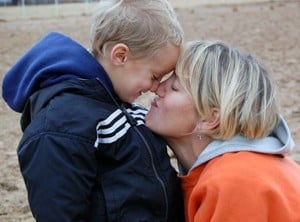UAMS Brain Aneurysm Procedure Puts Triathlete Back in Race
Sept. 3, 2010 |Triathlete Heidi Karsten-Zulliger of Conway was skeptical when told she was at high risk for a brain aneurysm. “I thought surely if I had an aneurysm it would have ruptured by now because I’m a very athletic person,” said the 40-year-old mother of three. That was two years ago, after her twin sister suffered a ruptured brain aneurysm and had a long, difficult recovery. Because brain aneurysms run in families, Karsten-Zulliger, an emergency room nurse, decided to have a brain imaging scan, but not before competing in a half Ironman. Initially she got good news when a neurologist found no aneurysms. But only a few months later she began to have frequent, severe headaches, and she became hypertensive. The symptoms made no sense to her given her otherwise great health. After about six weeks, she got another brain scan, and two aneurysms were discovered. One was in the same location as her sister’s. While her neurologist and a neurosurgeon recommended that the aneurysms be monitored, doctors she works with advised her to see Eren Erdem, M.D., an interventional neuroradiologist at the University of Arkansas for Medical Sciences (UAMS). “Hands down, they wanted me to go to UAMS and Dr. Erdem,” Karsten-Zulliger said. Erdem is the only board-certified interventional neuroradiologist in Arkansas, and his skills have been recognized internationally. At UAMS, he directs the Division of Interventional Neuroradiology, where he provides a non-surgical alternative to repair both ruptured and unruptured aneurysms. He also is well known in his field for treating vascular malformations of the head and neck and using an innovative procedure known as kyphoplasty to help multiple myeloma and osteoporosis patients who are immobilized by painful vertebrae fractures. In fact, Erdem leads the world in the number of multiple myeloma patients treated with kyphoplasty. Karsten-Zulliger said she was impressed with how quickly UAMS handled her case. “They were very efficient,” she said. “Dr. Erdem is a great listener, and he didn’t act rushed but took it seriously enough to act quickly. That really put me at ease.” Having researched her own condition and potential treatments, she found herself completely comfortable with Erdem and his recommendation. To treat aneurysms, Erdem uses a procedure known as coil embolization. During this procedure, a catheter is inserted in a major blood vessel in the inner thigh and maneuvered all the way to the brain. The coiled wire is threaded through a catheter sheath to the aneurysm. The coiled wire is added until it fills the aneurysm, and is left there, permanently. A clot forms around the coils like scar tissue, which blocks more blood from entering the aneurysm. More often than not, this is the preferred alternative to surgery for ruptured aneurysms, Erdem said. In a surgical procedure, a neurosurgeon has to manipulate brain matter to reach the aneurysm and clip it so that blood stops flowing into the aneurysm. Such invasive surgery has been shown to have worse outcomes than coil embolization for ruptured aneurysms, and recovery, which is more often incomplete, is much longer even for unruptured aneurysms. Karsten-Zulliger’s procedure was set just three weeks after her second brain scan. Coiling both aneurysms took more than five hours that Oct. 5, 2009. Today, Karsten-Zulliger said she’s back to doing all the activities she enjoys, even competitive running, swimming and biking. Her only restriction, per Erdem, is that she wear a heart monitor and keep her heart rate below 160 beats per minute. “Dr. Erdem told me later that one of my aneurysms was about to rupture, even when I was on the table,” she said. “I feel like I owe him my life.” |
 Heidi Karsten-Zulliger is grateful to be enjoying life
Heidi Karsten-Zulliger is grateful to be enjoying life
